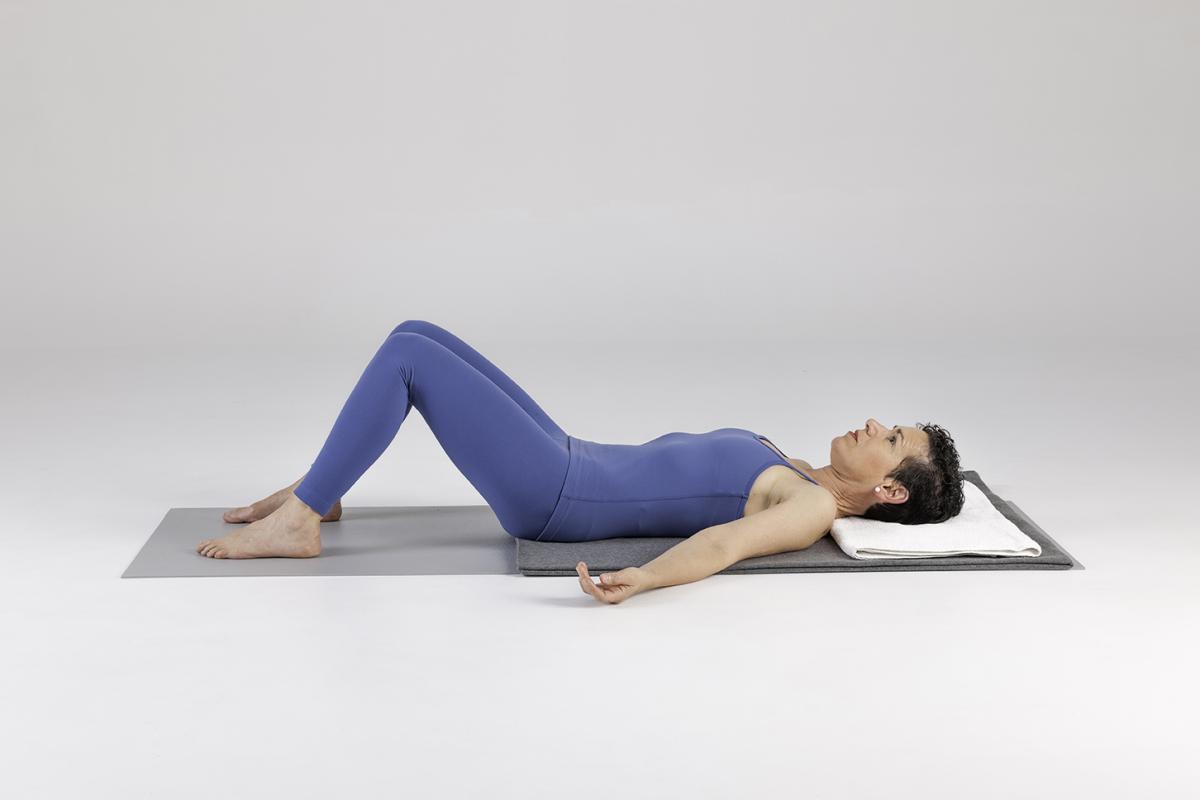Constructing Your Ideal iRest Position
Not everyone feels comfortable lying down with his or her legs extended for the practice of iRest® Yoga Nidra. While placing a pillow or bolster under the knees can be an effective solution for reducing pelvic and spinal discomfort for some, having other options up your sleeve can help you to develop a comprehensive tool kit of effective relaxation positions. "Constructive Rest Position" can be an ideal position for Yoga Nidra, not only because it helps to release the deep spinal muscles, but also because it offers a physical balance between attentiveness and relaxation.
Why
Constructive Rest Position (CRP) is both the go-to position for releasing the deep psoas muscles, and an excellent foundational practice for rebalancing and lengthening the entire spinal column. It is one of the most powerful practices that can be used for anyone with spinal discomfort. Careful placement of the legs in this pose establishes the skeleton as the primary support so that the deep core muscles can relax and release. The hip bones “plug into” the hip socket, and with the assistance of gravity, allow the spine to release. The subtle relaxed alertness required to maintain the position of CRP represents a balance between relaxation and positive tension. This balances the three pillars of the nervous system –– sympathetic (action and alertness), parasympathetic (rest and restore), and enteric (the brain in the belly). Resting in this attentive relaxation position may help you remain awake and alert for the practice of iRest.
How
To lie in CRP, place your feet far enough away from your buttocks that the upper and lower leg bones “rest against each other like cards” (Figure 1). If your feet are too close to the buttocks, you will find that your upper thighs are unnecessarily tense and that the weight of your body primarily will be on the ball of your foot. If your feet are too far away from your buttocks, the abdominal muscles will be too engaged and the weight of the body primarily will be in the heel of the foot. When the weight is balanced equally between the ball and heel of the foot, and you have some air space behind the knee, you are approaching the zone of an optimal CRP. Also check that the feet are hip-width apart; if the feet are too wide apart, the knees will fall inward; if the feet are too narrow, the knees will fall outward. Briefly, look down your torso and check that the thighs are in a parallel position and that the weight on your feet is balanced between the inside and the outside of the foot. Last, if you feel discomfort in your neck and it appears that your chin is higher than your forehead; place a folded towel under your neck and head so that the forehead is slightly higher than the chin. Use as much towel support as is necessary to feel comfortable, but do not use so much support that it causes the head to be raised significantly higher than the neck. Now relax for 5–30 minutes. If you are practicing iRest, and at some point no longer feel comfortable in CRP, simply extend your legs for the remainder of the practice.

Benefits:
Puts the body in an optimal position to release the psoas and spine. Alleviates compression in the lumbar spine and can release pressure in the sacroiliac joint. Calms the body, mind, and emotions while also promoting a sense of relaxed alertness.
Contraindications:
May be problematic for those with compromised disk integrity in the lower back. May be uncomfortable for those with inflammation in the sacroiliac joints or the lower back; try placing a folded soft towel, sheepskin rug, or a foam cushion under the pelvis.
You’ll Need
A yoga mat covered with a wool or cotton blanket. A towel.
Extracted from Pathways to a Centered Body: Gentle Yoga Therapy for Core Stability, Healing Back Pain, and Moving with Ease, by Donna Farhi and Leila Stuart. As an iRest subscriber you can receive a 50% discount on a digital copy of this book when you buy a hard copy from: www.embodiedwisdom.pub/pcb-ir (Please feel free to make copies of this pdf available as a download for your students or clients.)
This is the first of three contributed articles from Donna Farhi.
| Attachment | Size |
|---|---|
| Article 1 Donna Farhi iRest.pdf | 693.21 KB |